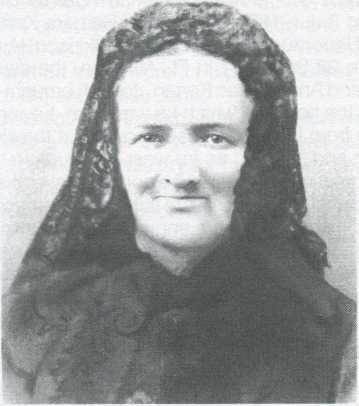|
Anna Mikota. Rev. Louis DeCailley, the priest from Twin Springs (later called Festina) conducted the ceremony. It is not known if the wedding took place there or at St. Clement's, a mission church built of logs which the German settlers had erected that year on a forty-acre site about a mile south of the future Spillville. Anna, the third eldest child of Frank Mikota and Mary Shileny, was born 3 Nov 1838 at Purkarec, Bohemia, in House #42. Her father, who also was born there, was a domkar (cottager) who had a small dwelling but no farmland. His occupation was that of a vratny (gatekeeper). This refers to the gates of the grist mill dam which spanned the Vltava River near his home. The gates permitted passage of log rafts and commercial boats bound for Prague. Frank’s father was also named Frank and also a cottager. The younger Frank's mother was Catherine Svoboda. Anna’s mother, Mary, was the daughter of Vaclav Shileny, a peasant farmer and village elder from Buzkov. and Anna Brom from Zahori. The Mikota home in Purkarec consisted of two rooms separated by the entry and a “black kitchen”. The latter derived its name from the thick coating of soot which had built up from year after year of cooking on an open hearth. The kitchen had no chimney. Smoke escaped though a hole in the ridge of the roof. One room of the home was occupied by Frank's family and the other by his retired parents. The doors were so low that even short people had to stoop to pass through; no two were the same height. 
Anna Klimesh Attached to the dwelling and in line with it were the granary and storeroom, a chicken coop and the cow barn. Opposite, across a narrow street, was a pigsty and a woodshed. Their garden, as well as a small duck pond, was between the house and the river. In the summer of 1980 the author visited Purkarec, he asked a lady working in her garden if she knew where house #42 was. She did not know but would ask her aunt: “teta bude vedet-Myaunt will know." This grandmother thought a moment, then replied: “To je u Mikotu-That is at the Mikota place.” Even 120 years after the Mikota family’s departure, the dwelling is still known by that name. The house appeared to have had few improvements during that time, other than electricity. Even the black kitchen, which in most homes has been remodeled and converted to other uses, was still in frequent use. On the day of the visit, Mrs. Ambroz, the housewife, was smoking hams and bacon. On the hearth was a big iron kettle which she said she used periodically to cook potatoes for the hogs. She also noted that she no longer used the stone oven which was built into one of the walls, but did her baking in an iron kitchen range in the room historically occupied by retired parents. It is very probable that the family is related to the Mikotas - when Anna Mikota was baptized, one of her sponsors was Johanna Ambroz. On 20 Apr 1857, at the clerk of court’s office in Decorah, John declared his intention to become a citizen of the United States and renounced “forever all allegiance and fidelity to every prince, potentate, state, sovereignty whatsoever, and particularly to the King of Bohemia of whom he is at present a subject.” John and Anna’s first home on the open prairie was a small log hut. A windbreak of Norway spruce was planted to protect the home from the cold, sweeping winter winds. When in time John replaced the cabin with a sturdy, thick-walled, two-story, limestone dwelling, oxen were used to dragjhe stone from a quarry with a sledge called a stone boat. Limestone was also used for the lower walls of the barn which was set into a slight slope, a practice he had locpughLwith him from Bohemia. For plowing, John used oxen. Since he had only four, he presumably doubled up with his father-in-law or another neighbor when breaking the virgin prairie. Prairie grass roots were thick and deep and turning over the sod required several yoke of oxen in front of the special plow, which had a wooden-mold board, edged in steel. Progress was slow and he was able to break no more than a few acres each year. In 1860, John had only 30 acres of his quarter section (160 acres) under cultivation. During the previous years, those acres had yielded 150 bushels of wheat, 30 of Irish potatoes, 100 of Indian corn, 29 of oats and 60 of barley. John had also cut 20 tons of hay, some of which was stacked over a framework of poles to provide additional shelter for his cattle. To cut the hay, John used a hand scythe. Though some horse-drawn implements were starting to come into use, John still did all his farming using primitive hand tools. The value of all his implements was assessed at $54.00. John pastured two cows which during the year had provided enough milk for the churning of 200 pounds of butter, four “other cattle” meaning calves, heifers or steers, and four hogs. The assessor set the value of John's livestock at $285.00. This included one horse, which he rode or hitched to a sulky, a means of transportation he used until his death. It was one of the few horses owned by Sumner Twp. Czechs at that time, though most non-Czechs had two or more. Through hard work and determination, John and his family prospered. K-29
|
Please, contact the County Coordinator to submit additions or corrections.
Winneshiek IAGenWeb Home
|
Please read the IAGenWeb Terms, Conditions & Disclaimer ~all of which applies to the Winneshiek Co. website. ~ this page was last updated on Monday, 29 March 2021 |